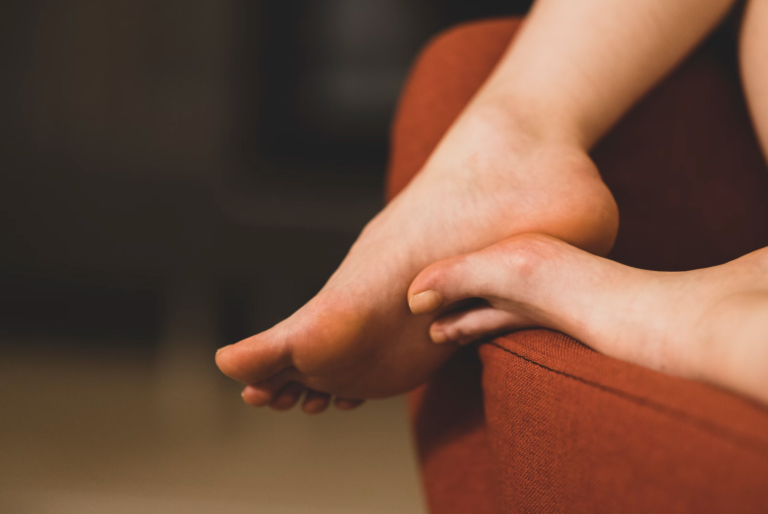Morton’s Neuroma | Causes, Symptoms & Treatment Options
Did you know about 7% of adults in the U.S. have Morton’s neuroma? It’s a painful condition where the nerve tissue between the toes gets thick. This issue can really slow down your life, making it critical to know the signs, symptoms, and how to treat it.
In this detailed guide, we’ll look at everything about Morton’s neuroma. We’ll talk about why it happens, what it feels like, and the many ways to treat it. After reading this, you’ll have what you need to fight back against Morton’s neuroma and get your foot health back.
Key Takeaways
- Morton’s neuroma is a painful foot condition caused by a thickening of the nerve tissue between the toes.
- Common symptoms include sharp, burning pain, numbness, and tingling in the affected area.
- Factors such as poor foot biomechanics, wearing tight shoes, and certain activities can cause this condition.
- First treatment steps usually include orthotics, steroid injections, and therapy.
- If the problem persists, surgery might be needed to help.
- Wearing the right shoes and caring for your feet can lower your chances of developing a Morton’s neuroma.
- It’s key to know the reasons, signs, and treatment choices for Morton’s neuroma to keep your feet healthy.
Understanding Morton’s Neuroma
Morton’s neuroma is when the nerve between the toes swells. This happens most often between the third and fourth toes. It can cause a lot of pain and sometimes makes your toes feel numb or tingly.
What is Morton’s Neuroma?
Morton’s neuroma happens when the nerve between the metatarsal bones gets swollen. This can be due to doing the same motions a lot, like in sports, or because of how your foot is shaped.
Anatomy of the Foot and Neuroma Formation
Our feet have many parts – bones, joints, and more. The metatarsal bones, near the toes, are where this nerve swelling often happens. When this nerve gets thick and irritated, a Morton’s neuroma forms.
Report from American Podiatric Medical Association
About 1 in 3 people get Morton’s neuroma. The American Podiatric Medical Association says that’s a lot. Knowing about foot anatomy and what leads to neuromas is key to treating and avoiding them.
Causes of Morton’s Neuroma
Morton’s neuroma is often caused by how you walk and your foot shape. It can also come from your shoe choice and how you live. Knowing what leads to this condition is key to stopping it and making it better.
Biomechanical Factors
If your feet are shaped oddly or you walk funny, you might get Morton’s neuroma. This happens because your foot’s nerves in the front get too much pressure. Things like having high or flat arches or not walking evenly can make these nerves thick and sore.
Footwear and Lifestyle Choices
Heeled shoes and tight ones that squish your toes are bad for you. They push on your foot too much, making those nerves angry. Doing things like running or jumping a lot can also make Morton’s neuroma worse. This is because your feet face a lot of stress and hurt over and over.
Other Risk Factors
Being too heavy or having diabetes makes getting Morton’s neuroma more likely. Too much weight and pressure from obesity are a problem. With diabetes, you might not feel it when your foot hurts. People with these issues need to watch out for Morton’s neuroma more.
Morton’s Neuroma Symptoms
The main symptom of morton’s neuroma is a sharp, burning pain in the foot’s ball. This often spreads to the toes. The pain gets worse with activities like walking, running, or wearing tight shoes.
Pain and Discomfort
People with morton’s neuroma feel a deep ache in their foot’s ball, around the third and fourth toes. This ache can be very bad, making daily life hard. It also makes standing or walking for too long painful.
Numbness and Tingling
Besides pain, others with this condition feel numbness, tingling, or a burn in their toes. This happens because the enlarged nerve tissue presses on other nerves.
Burning Sensation
The burning from morton’s neuroma can be quite tough to deal with. If not treated, it can get even worse over time. This pain is from a compressed and inflamed nerve, which can also cause other issues.
Morton’s Neuroma Treatment
The treatment often starts without surgery.
It might involve using special inserts for shoes. These can change how your weight is distributed. This eases pressure on the sore nerve. Doctors might also give shots of cortisone to bring down swelling and pain. Sometimes, exercises for the foot or physical therapy can make the muscles stronger. This improves how your foot works, helping your pain.
Conservative Treatment Options
The first step for morton’s neuroma is usually not surgery. Doctors recommend using orthotics that fit just for you. These change how your weight is spread and ease nerve pressure. Also, cortisone shots can reduce swelling and pain.
For immediate help, they give temporary relief.
Surgical Intervention
If the pain continues after trying everything else, surgery might be needed. During the operation, the thickened nerve is carefully removed. This can stop the pain but may lead to some toe numbness.
Prevention and Self-Care
To avoid or lessen morton’s neuroma pain, the right shoes are crucial. Stay away from high heels and tight shoes. Keeping a healthy weight and choosing gentler activities will help your feet.
Insoles Help Relief
Insoles can help relieve Morton’s neuroma symptoms by providing metatarsal support, arch support, and cushioning. They redistribute pressure away from the affected nerve and reduce stress on the forefoot. Choose insoles with a combination of these features that fit well and are compatible with your shoes.
Exercises for Morton’s Neuroma
Daily foot exercises can make a big difference. They make your foot muscles stronger and improve how your foot moves. This might include stretching, strengthening, and balance activities.
| Conservative Treatment | Surgical Intervention | Prevention and Self-Care |
|---|---|---|
| Orthotics | Neurectomy | Proper footwear |
| Cortisone injections | Permanent numbness | Healthy weight |
| Physical therapy | – | Low-impact activities |
| Foot exercises | – | Foot exercises |
Conclusion
Morton’s neuroma is a common foot condition that can really impact our daily life. We know a lot about how it happens and what it feels like. This helps us do things to make it better.
There are many ways to treat Morton’s neuroma. You can start with simple steps like using special shoe inserts or getting shots. More serious options include surgery. But don’t forget, choosing the right shoes and doing certain exercises can help a lot.
Understanding and acting early against Morton’s neuroma is key to feeling better and staying active. Quick action and help from doctors can really improve your future foot health.









